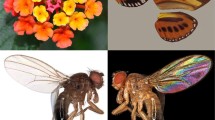Summary
The locomotory turns of the beetle Tenebrio molitor were recorded from free walking animals which were held in stationary position and orientation by means of a tread compensator. Striped patterns revolved around an animal elicit optomotor responses which undergo an inversion at smaller stripe widths. The position of the inversion point characterizes the resolving power of the motion detectors, and corresponds to a 6.5° average angle between the optical axes of interacting elements in the motion detecting device. This indirectly determined value is consistent with the anatomically measured 7° average angle between the axes of neighbouring ommatidia in the Tenebrio compound eye.
Similar content being viewed by others
Literatur
Braitenberg, V. v.: Patterns of projection in the visual system of the fly. I. Retina-lamina-projections. Exp. Brain Res. 3, 271–298 (1967).
Cloudsley-Thompson, J. L.: Photoperiodism and geotaxis in Tenebrio molitor. Proc. roy. ent. Soc. (Lond.) 28, 117–132 (1953).
Gavel, L. v.: Die „kritische Streifenbreite” als Maß der Sehschärfe bei Drosophila melanogaster. Z. vergl. Physiol. 27, 80–135 (1939).
Götz, K. G.: Optomotorische Untersuchung des visuellen Systems einiger Augenmutanten der Fruchtfliege Drosophila. Kybernetik 2, 77–92 (1964).
— Die optischen Eigenschaften der Komplexaugen von Drosophila. Kybernetik 2, 215–221 (1965).
— Flight control in Drosophila by visual perception of motion. Kybernetik 4, 199–208 (1968).
Grenacher, H.: Untersuchungen über das Sehorgan der Arthropoden. Göttingen: Vandenhoeck & Ruprecht 1879.
Hassenstein, B.: Ommatidienraster und afferente Bewegungsintegration. (Versuche an dem Rüsselkäfer Chlorophanus viridis). Z. vergl. Physiol. 33, 301–326 (1951).
— Kybernetik und biologische Forschung, S. 705–715. Handbuch der Biologie, Bd. I/2. Frankfurt a.M.: Athenaion 1966.
Hertz, M.: Zur Physiologie des Formen- und Bewegungssehens II. Auflösungsvermögen des Bienenauges und optomotorische Reaktion. Z. vergl. Physiol. 21, 579–603 (1934).
Kirschfeld, K.: Die Projektion der optischen Umwelt auf das Raster der Rhabdomere im Komplexauge von Musca. Exp. Brain Res. 3, 248–270 (1967).
Lohmann, M.: Der Einfluß von Beleuchtungsstärke und Temperatur auf die tagesperiodische Laufaktivität des Mehlkäfers Tenebrio molitor. Z. vergl. Physiol. 49, 341–389 (1964).
Perttunen, V.: Effects of desiccation on the light reactions of some terrestrial arthropods. Ergebnisse der Biologie, Bd. 26, S. 90–97. Berlin-Heidelberg-New York: Springer 1963.
Reichardt, W.: Quantum sensitivity of light receptors in the compound eye of the fly Musca. Cold Spr. Harb. Symp. quant. Biol. 30, 505–515 (1965).
Wada, S., u. G. Schneider: Eine Pupillenreaktion im Ommatidium von Tenebrio molitor. Naturwissenschaften 54, 542 (1967).
— Circadianer Rhythmus der Pupillenweite im Ommatidium von Tenebrio molitor. Z. vergl. Physiol. 58, 395–397 (1968).
Author information
Authors and Affiliations
Rights and permissions
About this article
Cite this article
Götz, K.G., Gambke, C. Zum Bewegungssehen des Mehlkäfers Tenebrio molitor . Kybernetik 4, 225–228 (1968). https://doi.org/10.1007/BF00272520
Received:
Issue Date:
DOI: https://doi.org/10.1007/BF00272520




